How to Shrink a Picture Size to Upload
Finding the Universe contains affiliate links, meaning if y'all make a purchase through these links, we may earn a commission at no extra cost to y'all.
As a lensman who is also a blogger, I am frequently asked how to reduce epitome sizes. This tin can be useful for a variety of reasons, from sending an prototype by email, through to optimizing images to improve website loading times. I idea a mail service explaining exactly how to reduce image sizes in general, and also how to optimize images for a website specifically would help answer that question.
In this post I'thousand going to cover a few things. I'll explain how to reduce image sizes for any purpose you lot want to use them. This may be for sending in an electronic mail, uploading to social media or an online photo gallery, or because y'all want to host them on a website or blog.
If you are uploading your images to a website, I'll explain why it's important to optimize your images for your website. Then I'll encompass the various different options you take for doing so, from software tools on your computer through to Cyberspace hosted options and plugins for WordPress.
Finally, for the website owners amidst yous, I'll give some more full general tips for improving your site load time that relate to how images announced on your site.
This mail service covers a lot, and then feel gratuitous to utilize the tabular array of contents to find the specific section that applies to you!
Table of Contents
Why Do You Demand to Optimize Your Images?
If y'all have a large library of images, you will observe that they take up a lot of infinite. And then the main reason to optimize your images is and so that they take up less space. This may be to free up your own hard drive space, or it may be because y'all want to share them with friends and family, and the files are too large to share.
If you are hosting a website, and so in that location's another proficient reason to optimise your images, and that reason is site speed.
If you visit a website like this one, you lot volition detect that it has a lot of images. Images are important for carrying information and illustrating our content – the Internet without images would be quite dull!

Nonetheless, images files are large files, taking up quite a lot of infinite. An average image file in the standard JPG format, as taken direct from your photographic camera or phone, will ordinarily be effectually four – 7 megabytes in size.
If you have an commodity on the web with 10 pictures, that would equal 40 – 70 megabytes of data that your web browser would have to download so yous could read it. And that'southward not fifty-fifty counting anything else that might be on the page, which besides incorporate text, scripts, etc.
Trying to load a webpage with twoscore megabytes of images would have time, even on a fast net connection! On a slow mobile connection, it would take what might feel like forever.
And speed matters to users. In fact, studies have shown that over 50% of mobile users volition leave a site if it takes more than 3 seconds to load. The BBC learnt that for every extra second a site takes to load, another ten% of users volition leave.
If yous take a website, I can recommend running information technology through Google's "Test my site" tool, which will requite you an indicator of how fast your site loads. The target is nether 3 seconds. Pages on this site average around 2 seconds on that tool.
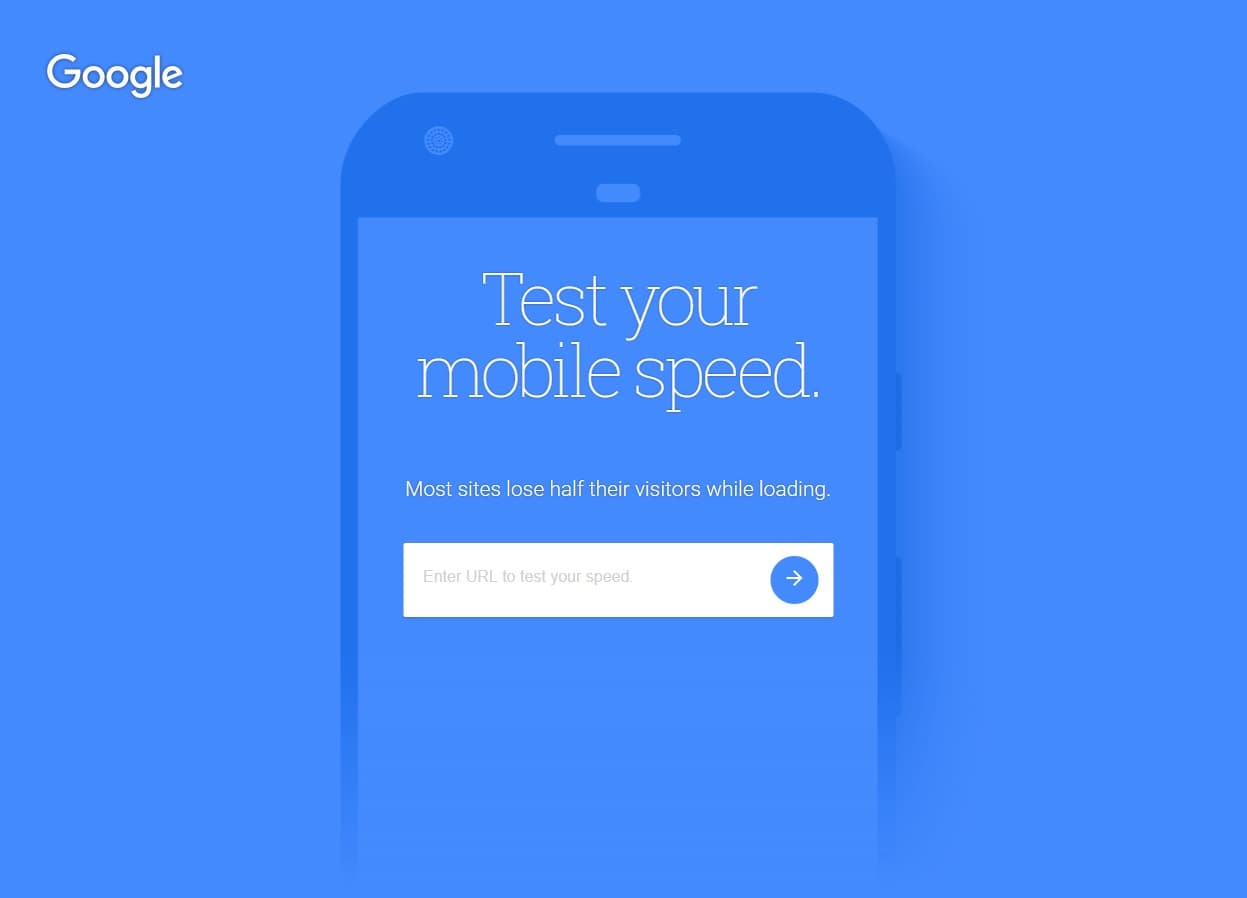
It'south not only users who like fast sites though. When deciding where to rank pages in its search results, Google uses site speed as 1 of its many ranking factors. That ways that if you accept a website that you want to rank well in Google, you need to exist thinking near how fast it loads. And optimizing your images can go a long way to a faster site.
Google provides another tool to exam site page speed and provide detailed tips for improving your site speed: Google PageSpeed Insights (PSI). Nosotros highly recommend running your website through this tool to see what results it comes up with.
On this website, we score around 85 – 92 on the mobile version of PSI, and 97 – 100 on the desktop version. Much of that score comes from having well optimised images.
Now allow'south look at the next point, which is besides ofttimes a indicate of defoliation when it comes to images – the difference between the size of an epitome, and the compression of an image.
Epitome Size vs Image Pinch, an Explanation
In my example to a higher place, I suggested that if yous grab your photos directly from your camera or smartphone, and uploaded them to the web or emailed them to friends, they would be around 4 megabytes to 7 megabytes in size.
Size in this case is a measure of how big the paradigm file is. This file size is the upshot of two things, the dimensions of the epitome (besides, often confusingly called size), and how compressed the image is.
These are two distinctly different things, and it'due south important to understand and tackle both of them, especially for website optimization.
Image Size
When we talk about the size of an epitome, we can either be referring to the file size, measured in bytes, or the dimensions of the image, measured in pixels. I will explain both of these and how they chronicle to each other.
When y'all accept a film on your camera or phone, the camera will have a "megapixel" rating. This refers to how many pixels make up the image the camera takes.
For instance, a 12 Megapixel camera, such as those found on many smartphones, will take an paradigm that consists of twelve million pixels. This image volition be 4000 pixels wide and 3000 pixels high, and you multiply one by the other to go the total number of pixels.
If the file is uncompressed, information technology volition 1 accept one byte of data to represent each pixel. So a twelve-megapixel image will consist of twelve meg bytes.
On the spider web, too every bit in popular messaging applications, very few people are using screens big enough to brandish an image 4000 pixels wide. In fact, the average screen resolution as of December 2018 is simply 320 pixels wide by 640 pixels high, largely due to the fact that so many people are browsing the cyberspace on mobile devices.
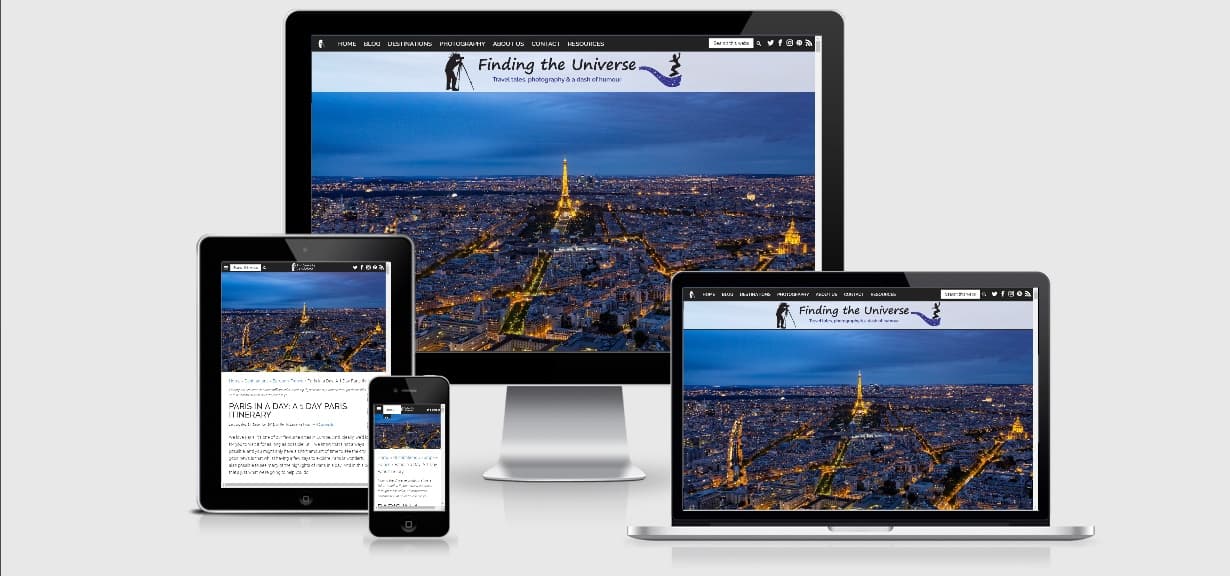
Showing a 4000 pixel wide image on a 320 pixel wide screen is going to be a huge waste of bandwidth, as the browser is just going to shrink it down to 320 pixels wide anyway.
Obviously, an easy win hither is to resize the paradigm first before information technology is sent to the web browser. Unless you have a really adept reason for a larger image, such every bit a actually wide header image that you think will appear on wide monitors, we would not recommend using images larger than around 1000px wide on your website. Most people apply ones that are even smaller and 640px, 800px and 1024px are common image sizes.
For instance on our travel blogs, we apply 800px images on Contained Travel Cats and 2000px on Finding the Universe.
If we take the 4000 x 3000 prototype, and size it down to a more reasonable 1000 x 750 pixels, we will take it from existence 4 megapixels to a more than reasonable 750 kilopixel size. Assuming one byte per pixel, that's a 750kb epitome.
Of course, 750kb is still a bit much for each image on your site, where y'all are likely aiming for images between 50kb and 300kb in size.
The side by side flake of good news is that this is also doable, using what is known as image compression.
Image Compression
If yous have been paying attention, you'll have noticed that I initially said that a 4000 10 3000 pixel image will exist 12 megabytes in size, but that an average image taken from a camera or smartphone with a 12 megapixel camera is likely going to be between 4 and seven megabytes.
Conspicuously, something is happening hither. And that something is what we telephone call paradigm compression.
JPG, or JPEG, is a compressed image file format. Different a RAW prototype file, which is just the RAW data that your camera saves (see more than on RAW here), a JPG file is a processed and, most chiefly, compressed file format.
Image compression is a clever technique where the file size of an paradigm is reduced using various algorithms. Information technology's pretty smart stuff, and can be done using either "lossless" pinch, or "lossy" pinch.
Don't worry, we're nearly at the bottom of the rabbit pigsty.
Lossless compression is a means of compressing images so they don't modify visually at all, simply still reduce in file size. Information technology's dandy for image quality, but doesn't brand a lot of difference to the actual file size as not much data tin be removed without affecting image quality in some way, however minor.
Lossy compression is more aggressive, and reduces the file size by reducing the quality of the image. With JPG pinch, this is often measured on a sliding scale from 1 – 100, where 100 is no image quality reduction, and i is maximum image quality reduction. Note that this is non a linear calibration, and decreasing from 100 to 80 volition usually give much greater savings than going from say 60 to 40.
In my experience, you tin compress a file with JPG compression at around a 76 – lxxx pinch size without noticeable changes in image quality that near users will exist able to observe.
So what difference does this really brand to the file size of an prototype?
Well, permit me take an example image file, which is 4000 x 3000 pixels.
At full size, so 4000 ten 3000 pixels, the following lossy compression settings when exporting the image from Adobe Lightroom CC yield the following results:
JPG at 100% – ten.3 MB
JPG at 80% – 4.5 MB
JPG at 75% – three.four MB
If we then reduce the prototype dimensions to 1000 x 750 pixels, and do the compression again from Adobe Lightroom CC:
JPG at 100% – 764 kb
JPG at 80% – 411 kb
JPG at 75% – 332 kb
Equally you tin see, we are making progress! However, we are not done yet.
Complimentary Tools to Reduce Prototype Size
In that location are a number of tertiary-political party tools which are specifically designed for epitome optimization for the web, which can produce much more impressive results.
Remember, you're going to need to do two things. First, you're going to demand to resize your images. Some tools that let you do that are equally follows. These are all free.
- Microsoft Powertoys for Windows (adds a handy resize option to the right click context menu)
- iResize for Apple tree devices
- Snapseed for Android / iOS (likewise as being an amazing photo editor, information technology besides lets you set an export size in pixels for your edited images
- Adobe Creative Deject Express – a complimentary online tool for resizing images
Once the prototype is resized, you will want to shrink it. The tools I suggest trying are:
- FileOptimizer (free, Windows)
- ImageOptim (free, Mac and online)
- Compress JPEG (online tool)
- Image Size (Android / iOS). Free up to 100 images a calendar month.
If y'all're just looking to resize images apace and easily, so an online tool is probably going to be the fastest option. If you observe yourself resizing images a lot, and so a defended tool is a good pick.
I'yard going to compare the results of paradigm compression using Romeolight JPEGmicro (no longer available), FileOptimizer and Compress JPEG against Lightroom, and then you can see the difference they make in file size. Yous'll likewise see how different pixel sizes touch on file size.
Setting these to compress to JPG at 75%, the post-obit results are had from our files. Compare them to the Lightroom version.
Lightroom at 75%:
4000×3000 pixels: 3.4MB
1000×750 pixels: 332 KB
Romeolight JPEGmicro at 75%
4000×3000 pixels: 1.7MB
one thousand×750 pixels: 163 KB
FileOptimizer at 75%
4000×3000 pixels: three.3 MB
thou×750 pixels: 156 KB
CompressJPEG at 75%
4000×3000 pixels: 1.8 MB
1000×750 pixels: 123 KB
Every bit you can see, theses dedicated paradigm pinch tools produces much smaller file sizes, especially of the smaller images which is what we are specially interested in.
If you are just looking to optimize your images for sending in due east-mails or to send to friends, I'd suggest using one of the above tools, or something like.
If you are looking to optimize your images for your website and y'all host your site on the free version of WordPress (wordpress.com) or on a site like Blogger, Wix, Druple or Joomla your best option is to optimize using the above tools.
If you are looking to optimize your images for employ on a cocky-hosted WordPress site, read on for some meliorate options.
WordPress Image Optimization Plugins
I know what you're thinking. This all sounds similar a lot of work. First you have to edit your photos, then yous have to resize them, then you have to shrink them earlier you even upload them.
Wouldn't it all exist a lot easier if there was an automated procedure to do all this?
I accept good news – there is! If you're hosted on WordPress, then you can install plugins that will handle these tasks for you, and produce great results doing so. I've taken a expect at some of the nearly popular options to give you an idea of what'due south available.
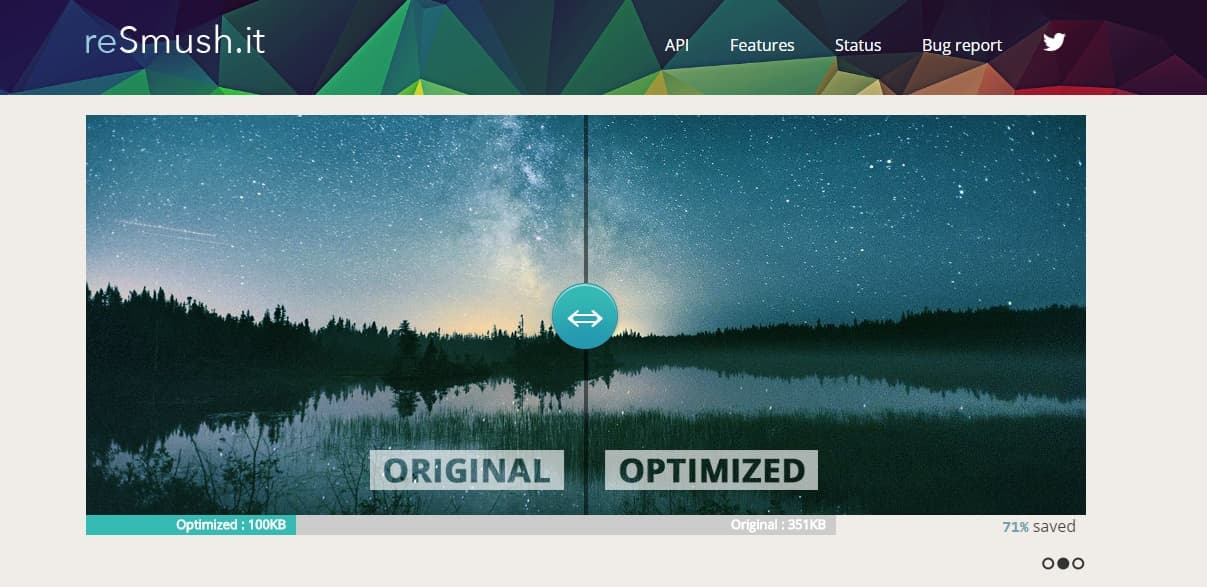
For each of the services on the list I took my 1000px x 750px exam image as exported from Adobe Lightroom, and tested the pinch bachelor if they offered a complimentary service.
Delight note that this is by no means a definitive test, the goal is just to demonstrate how these online services compare to doing it using a desktop-based solution like those listed above. A detailed examination would crave using a wide range of images of different subjects to define a articulate winner. This comparison is simply to show that each service offers a roughly comparable result.
As well, it's difficult to compare some of these services directly every bit each service has slightly dissimilar settings that you can adjust. In an ideal world, I'd be able to set each 1 to 75% quality for a more precise examination, but many of these services don't offer that level of control.
However, as a general overview of what is available, I believe this list volition help yous make up one's mind what might piece of work for you.
Without further ado, here are some of the best WordPress Image Optimization Plugins to consider, along with details of pricing and features they offer.
1. ReSmush.It
Resmush.it is the service we use on our sites for prototype optimization. It offers fine grained control over the quality settings, and it creates a backup of your original image file on your server so you lot can always change the settings if you want, and you won't lose your original file.
You can optimise images on upload, plus there's a bulk optimization tool to allow you to optimize your whole library. The WordPress plugin is easy to utilize, and the results, in our experience, are excellent. Also, it'due south entirely costless!
Resmush.it at 75%
yard×750 pixels: 143 KB
Pricing: Free, maximum image size 5MB.
2. ShortPixel
ShortPixel offers compression for JPG, PNG, GIF and WebP files, as well as conversion from JPG, PNG and GIF to WebP. WebP is a newer epitome file format that offers improved compression, but is not universally supported by browsers yet, so requires some effort on your role to implement on your website.
Other features include bulk prototype optimization of your media library, no file size limit, and excellent support. You tin can also run it on multiple websites with 1 license.
In terms of image compression, ShortPixel has three settings, Lossy, Glossy and Lossless. Lossy is the most aggressive, Glossy tries to produce skillful results but with higher image quality, and lossless is the highest image quality, which won't make also much difference. Currently you can't suit the specific compression amount though.
ShortPixel with Lossy Compression
yard×750 pixels: 91.1 KB
Personally, I have to admit that I discover the lossy compression on ShortPpixel produces images that are a little chip also soft, merely if they work for yous that'southward smashing, equally the file sizes are definitely the smallest of all the plugins I've tried. They accept another option for picky people like me though: Glossy.
ShortPixel with Glossy Compression
grand×750 pixels: 182 KB
Nonetheless a proficient effect, although the lossy results are definitely more impressive in terms of file size reduction, if yous are happy with the image compression results.
Pricing:First 100 compressions a month gratuitous, then various pricing models. Nigh will be fine with the USD $v /mo five,000 prototype programme or the USD $10/mo 12,000 image a month programme. I-time bulk image optimization plans are also available.
three. Kraken.io
Kraken.io offers JPEG, PNG and GIF pinch, with support for files upwardly to 32MB in size. Images can exist automatically resized on upload, and you have fine grained command over the resize options, including a lossy, lossless, and adept setting. The latter lets you selection the exact image quality you want the algorithm to use.
Kraken.io at 75% (expert setting)
1000 x 750 pixels: 155 KB
Pricing:Unlike tiers available, from USD $50 / year for 500MB of images a month up to USD $790 / year for 60 GB of images a month
4. TinyPNG
Despite the proper name, TinyPNG offers both JPG and PNG file pinch. Information technology offers bulk optimization of your image library, optimization on upload, and the option to resize images on upload. You can use your plan beyond multiple websites, and there are no file size limits.
Nevertheless, you cannot currently choose the compression level as the service does this per prototype. Nevertheless, results are certainly in line with the other tools in this list.
TinyPNG at default setting
1000×750 pixels: 141 KB
Pricing:Start 500 compressions a month free, then USD $0.009 / image upward to x,000, and then USD $0.002/image.
five. Imagify
Imagify offer optimization of JPG, PNG and GIF files, and you can use your assart across multiple sites. Information technology besides offers the option of image resizing, which is a handy feature.
Three tiers of image compression are available, Normal, Ambitious and Ultra. In my testing using the spider web interface, these all ended up producing the aforementioned upshot across a multifariousness of files I tested, which I can only assume to be an error, as the resulting file was much larger than with the other services.
As with the other services, a WordPress plugin is available.
Pricing is based on the gigabytes of images you send beyond, with Imagify estimating that 1GB is equivalent to ten,000 images. Plans are available on a monthly, annual, or one-time basis.
Imagify at Ultra setting
1000×750 pixels: 271 KB
Pricing: USD $49.90 / year for 1GB of images a calendar month, USD $200 / year for 5GB of images a month. Other tiers bachelor.
6. EWWW.IO
EWWW.IO offers compression of JPG, PNG, GIF image files, and as a bonus, you tin can also compress PDF files. Information technology also offers WebP conversion of images, bulk optimization of your entire media library or specific folders, and it will resize your images on upload as well.
Quality settings are fine out of the box for nearly users, but avant-garde users can adapt this quality setting if desired.
EWWW.IO with lossy setting
thousand×750 pixels: 158 KB
Pricing: USD $0.99 for API access, and so USD $0.003/prototype (commencement 500 images are free)
6. More options
There are a number of other options that offer like functioning with different pricing models. These include Optimus.io ($29 / year, unlimited utilize) and WP Smush Pro ($49/mo for WPMU subscription).
I did not include them in the round-up equally they don't allow for a free exam, but as the underlying applied science is pretty much the same, I would suspect they would offering like results.
Optimus.io in particular has a very attractive pricing model, and also includes WebP conversion, a 10MB maximum file size, bulk conversion, and the option to arrange the quality setting if required.
Summary of WordPress Image Optimization Plugins
Every bit you can run across, these paradigm optimization plugins offer equivalent compression to a desktop-based solution, with a number of advantages.
Outset, the images are compressed as you upload the file, and then you lot don't have to worry nearly performing actress steps before you upload.
Second, they compress all the versions of the image that WordPress generates, besides as the original image file. Every fourth dimension you lot upload an image, WordPress creates a number of versions of information technology, which are used for different things similar blog post thumbnails, featured images or header images.
By default, these are not well compressed, and these plugins handle the compressing of these files, which saves you server space as well.
Still, when comparison pricing, recall that each of these images counts every bit a conversion. On average WordPress volition have five versions of each image, so if yous use a service which charges per image compression, each image you lot upload to WordPress volition use upward 5 of your credits.
And then, which one to choose?
Well, I utilize resmush.it on our sites. It's free, which is a huge bonus, the compression is excellent, and when I've had issues the squad has been very responsive.
My second pick would be Optimus.io. Whilst I didn't exam it, the pricing is swell and user reviews are positive.
Finally, I can also recommend ShortPixel. They have an like shooting fish in a barrel-to-understand interface, and produce great results – particularly with the lossy setting. With support for WebP conversion of images, and unlimited file sizes, plus peachy support, this is 1 of the ameliorate premium paid options.
Finally, it's worth pointing out that in my experience there is is no i "best" option when it comes to image optimization, and as I've just tested one image on each service, this is plain not a definitive comparison.
My advice is to pick the plugin or tool that fits best into your workflow, has a toll model that works for you lot, and use that.
Other WordPress Image Plugins to Consider
Whilst the in a higher place plugins do a peachy job of compressing the images, they aren't the only pick out at that place for improving your paradigm workflow, and I wanted to include a couple more options for yous to be aware of on WordPress.
Imsanity
Imsanity is a tool that saves you the attempt of having to call up to manually resize your images. Whilst many of the plugins on this list besides do this for yous, not all of them exercise, and Imsanity is a free plugin from the creators of EWWW.io which will resize your images automatically on upload.
So if you lot accidentally upload an image at 4000 pixels wide, Imsanity volition calibration this down for you to a more manageable size. You set up the size yourself.
JetPack
Jetpack is a multi-purpose plugin that tin exercise all sorts of handy things for a website. It has two really useful features when information technology comes to images – it supports lazy loading of images (more on this shortly), and it also has a really corking image compression characteristic built in called Photon.
Photon is a service which basically takes the images from your posts, compresses them (you tin configure how much), and then returns the optimized images from the Jetpack CDN. This reduces the bandwidth load on your server. Even better, this service supports WebP conversion too, so if a user visits your site with a browser that supports WebP images, they volition automatically be served a WebP paradigm with no attempt required on your function.
If you accept JetPack, I can highly recommend enabling this feature, forth with the lazy load feature, and then you won't take to install whatever of the other plugins on this page at all. It's a part of the complimentary Jetpack plugin on WordPress.
More than Tips for Loading Images on WordPress
Now that y'all have optimized images, there are a few more tweaks you can implement when information technology comes to prototype loading on your site for maximum performance.
Serve the right sized images for the user'southward device
People browse the web on a broad variety of devices these days, from smartphones, through to tablet devices, laptops, and desktops.
Each of these devices has a different screen size, and displaying the same image on each device can exist a huge waste of bandwidth – even if the image is compressed.
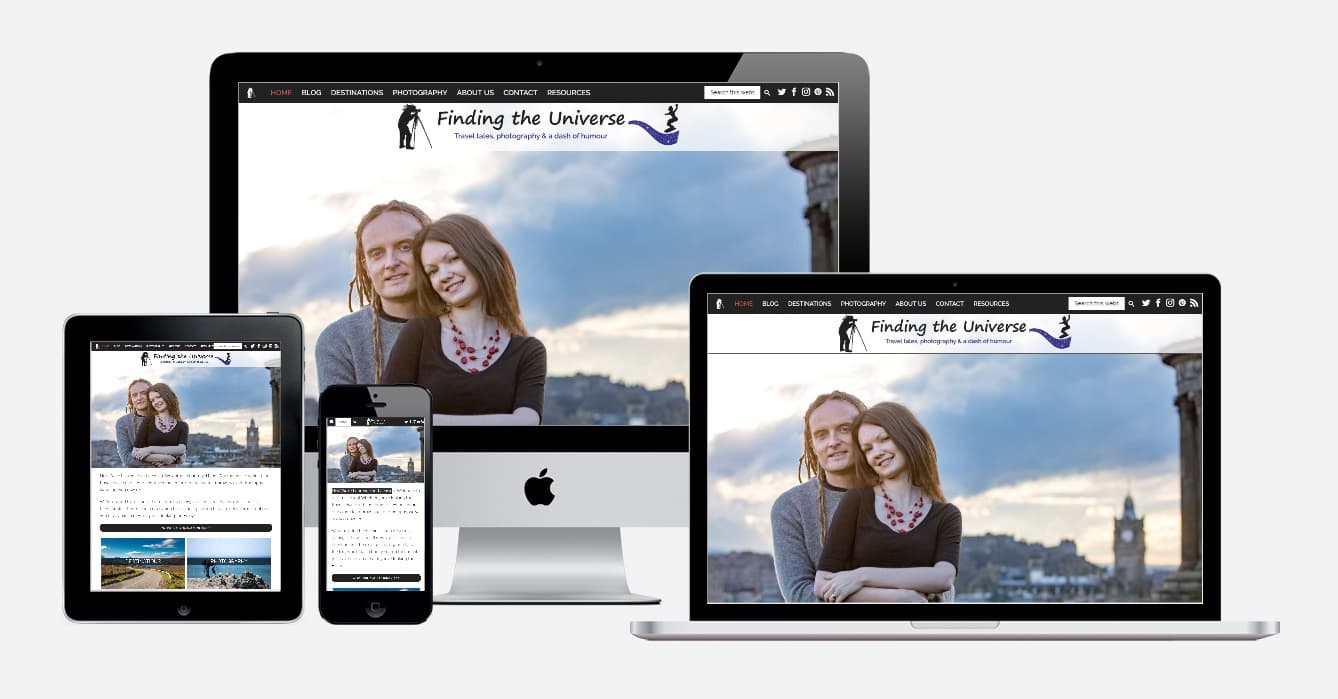
Let'due south look at an example, a mobile user visiting your site on a 320 pixel wide screen, and a desktop user visiting your site on a 1366px wide screen (these are the about common mobile / desktop prototype screen width every bit of December 2018).
The 1366px wide paradigm is 230 KB after compression at 75%.
The 320px wide image is 30KB after compression at 75%.
This is a massive deviation. Clearly, in an ideal globe, you desire to brandish images to the user that near closely lucifer the screen size of the device that they are browsing your site with. There's no need to send them an image that is wider than the screen they are viewing it on, as it's a waste product of bandwidth.
Unfortunately, implementing this is non as like shooting fish in a barrel as installing a plugin. It will be specific to your site design and theme, and will require some coding, besides as deciding what sizes of epitome you want to produce. At that place's a good guide here to doing information technology, but nosotros would recommend getting a web programmer to help if you equally it requires lawmaking changes.
Lazy load images
An like shooting fish in a barrel and really quick win to improving your sites load times is to lazy load the images on your site.
What does lazy loading mean? Essentially, this is a technique which is widely used across the web, which ways that only the images that are actually on the screen are loaded. Images further downwardly the page do not load until the user scrolls their browser window, meaning that these images do not have an touch on on the initial site load time.
Lazy loading is easy to implement on WordPress, with multiple plugins available that offering this functionality. Our current favourite is Lazy Loader, only we accept as well used BJ Lazy Load and a3 Lazy Load with good results.
In Summary
I appreciate that this was a lot of information, so I wanted to provide a brief summary of all the above, with some actionable steps you can have to amend paradigm load times on your own website.
v Steps y'all can take to improve epitome load times on your website
Step ane: Resize your images to an appropriate maximum size for your site.
Usually this will be betwixt 1000px and 2000px broad. Y'all can do this prior to upload, or using an prototype resizing plugin similar Imsanity.
Step 2: Shrink your images as much as you are comfortable with.
The easiest way is with a plugin similar those mentioned above, including Resmush.it, Optimus.io or ShortPixel.
Step 3: Use a lazy loading plugin to load images
This will increase your site load speed, as images will only load as they are needed, rather than upwardly front all at once.
Step 4: Serve images to users based on the width of their device
Having highly compressed images is only part of the solution – there'due south no point displaying images that are far wider than their browser. Y'all tin can save a lot of bandwidth and increment site load speeds by loading the right size of image, based on the width of the user'southward browser window.
Step 5: Exam!
Use services similar Google's Testmysite and Pagespeed Insights to ensure your site images are equally optimized as possible.
Concluding Tip
Information technology's worth pointing out that epitome sizes are merely 1 part of optimizing your website for speed. Whilst images tin can brand a pregnant departure in site speed, there are a number of other factors to consider. Practiced hosting is an of import get-go beginning. If you don't have a fast website host, and so yous'll e'er have an uphill boxing when it comes to site speed.
We host all our WordPress sites on Cloudways, and have done for a number of years. We've tried a variety of other hosts, and in our experience Cloudways is the best balance of cost and performance. Y'all tin can read our full Cloudways review here.
We have an exclusive discount code for Cloudways, which will give y'all 10% off your hosting for the first three months. Only use the codeTRAVELCATS when you sign up.
Further Reading
Hopefully this guide to paradigm optimization for the spider web and WordPress sites in particular has helped you get some ideas for how to improve your site load times.
We take a number of other articles and resources that we think you will find useful, covering both blogging and photography. Here are some to get you started.
- Our guide to how to be a travel blogger, which is a good starting point if you lot are thinking of starting your own blog.
- Speaking of which, we also have a stride by step guide to the procedure of how to first a travel weblog from scratch, which covers everything from picking a domain name to choosing a host.
- I started this weblog on the Blogger platform. This turned out to exist also restrictive for my needs afterward several years, so I migrated to WordPress. Yous tin can see my guide to moving from Blogger to WordPress here.
- Photography is a primal chemical element of a travel blog, and I have a whole series of photography guides to aid you out. These cover topics from limerick and depth of field, to improving Lightroom performance and an overview of what RAW is.
And that's it. Equally always, nosotros're happy to take your questions and hear your feedback about any of the in a higher place. Just pop them in the comments below, and we'll get back to y'all!
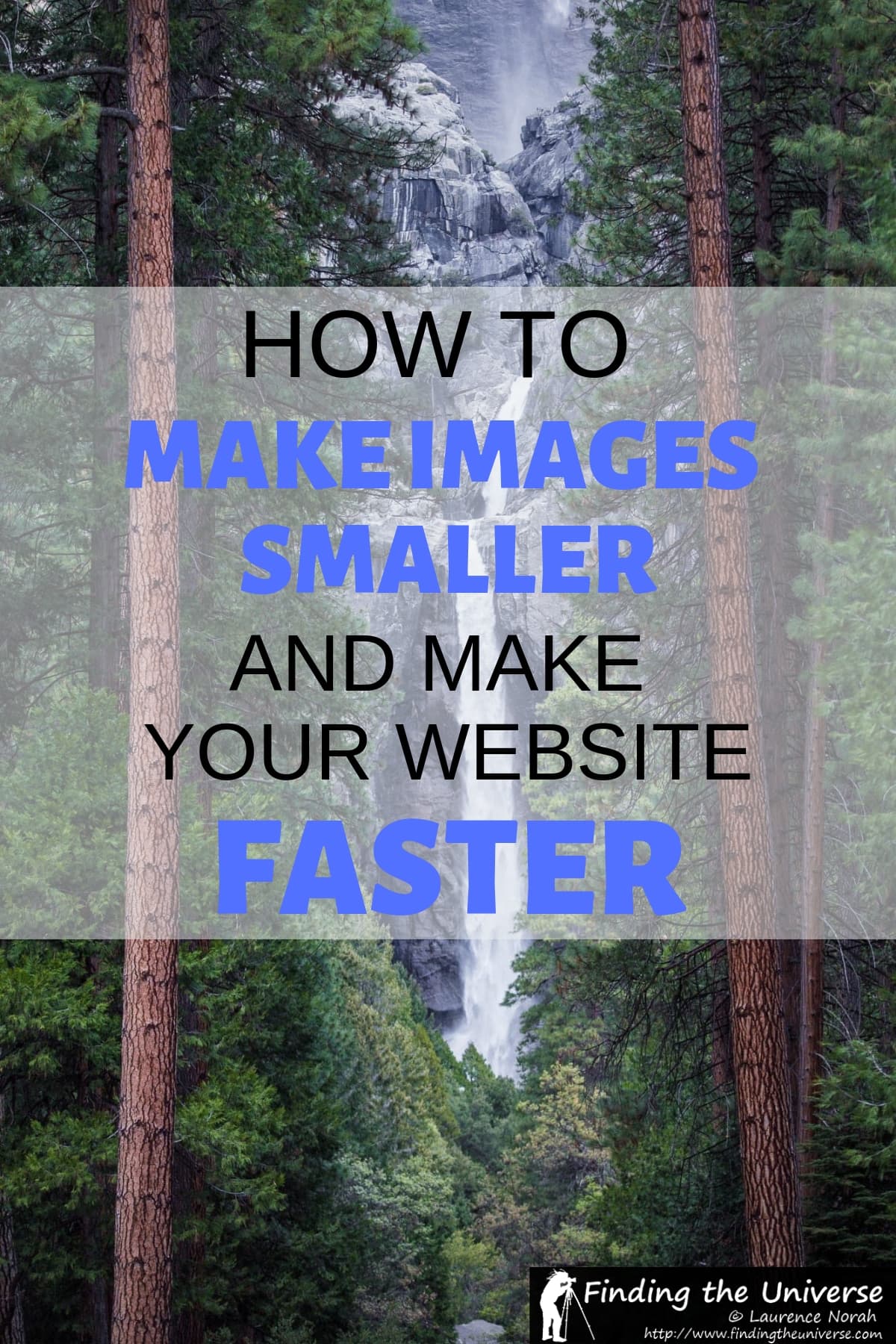
pepperthatheriams.blogspot.com
Source: https://www.findingtheuniverse.com/reduce-image-sizes-and-improve-site-speed/
0 Response to "How to Shrink a Picture Size to Upload"
Post a Comment